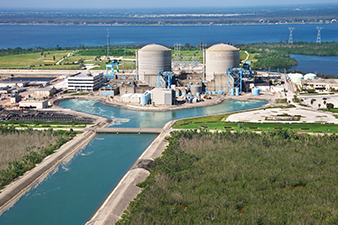
The energy industry is undergoing a rapid transformation. The utility control center, and specifically the control room operator, will play a central role in managing this transition as the grid becomes more complex. These highly trained personnel continuously monitor the electric system and react to emergent conditions. This role is evolving, as changes in the industry are driving new considerations for how utilities think about their control center operations, described below:
- A changing generation mix, comprised of more intermittent renewables, energy storage, and fast-responding natural gas, requiring more active dispatch to maintain grid stability.
- The proliferation of distributed energy resources (DER), resulting in two-way power flows on the distribution network with the potential for localized disruptions and power quality issues.
- Advancements across a spectrum of grid technologies, putting more tools at a utility operator’s disposal, including smart inverters at the grid edge, SCADA-enabled switches and controllers, high-speed telecommunication networks, advanced control systems, data analytics, and digital twins.
- Electrification of buildings and transportation, reducing the margin of error and increasing the cost of electric service disruptions as society becomes more dependent on reliable and resilient electricity.
- New regulation and market services, creating participation opportunities for aggregated or standalone resources and requiring new processes and operational protocols for utility control rooms.
- A workforce transformation as the baby boomer generation nears retirement, requiring focused attention and investment in recruiting, training, and knowledge transfer.
T&D leaders facing these challenges should consider the following:
1. Assess and adjust the skillsets needed on operational teams
Understanding skill gaps begins with understanding how current operations personnel are spending their time. A structured assessment that fully accounts for the team’s time can be a source of actionable insights. For instance, significant operator time and attention may be diverted to technology implementations or the switching orders and commissioning of new field devices. With a data-informed approach, leadership can make more informed decisions about which responsibilities should be handled by which role or create new roles to unburden operators handling these responsibilities on the “side of their desks.” One common example is to centralize operational technology (OT) expertise in roles or teams that combine technical expertise and digital skills or to add operational engineers to provide decision-making analytical support.
2. Consider new roles to manage emergent technologies
 As the technical tools available to control room operators expand, the operations team may consider establishing new roles that provide specialized services to complement traditional monitoring and control functions. One approach to meeting the complexity of dispatching aggregated or standalone DER with specialized control systems (like DERMS or DRMS) is dedicating desks or even entire control rooms to renewables or DER control. Another technology-centric new function is a diagnostic center—an operational team that assesses the vast streams of data coming to the control room through field sensors, customer meters, and other data sources to provide recommendations to operators and dispatchers (see sidebar). Establishing these new functions takes time and planning. In addition to determining staffing levels and the technology needs, the governance of all activities should be clearly defined, and new processes that define handoffs and coordination should be developed.
As the technical tools available to control room operators expand, the operations team may consider establishing new roles that provide specialized services to complement traditional monitoring and control functions. One approach to meeting the complexity of dispatching aggregated or standalone DER with specialized control systems (like DERMS or DRMS) is dedicating desks or even entire control rooms to renewables or DER control. Another technology-centric new function is a diagnostic center—an operational team that assesses the vast streams of data coming to the control room through field sensors, customer meters, and other data sources to provide recommendations to operators and dispatchers (see sidebar). Establishing these new functions takes time and planning. In addition to determining staffing levels and the technology needs, the governance of all activities should be clearly defined, and new processes that define handoffs and coordination should be developed.
3. Partner with HR to develop workforce plans
As roles become more specialized and technology-centric, operations teams will need additional highly skilled personnel. Finding individuals with a combination of power system engineering and technology skills can be challenging. The demand for such professionals is high, and the supply is limited. T&D organizations must partner with their HR business partners to navigate a competitive market to secure the talent they need. Retention becomes equally important, as losing skilled personnel can disrupt operations and hinder the organization’s progress. A robust talent acquisition and retention effort should be informed by a workforce plan that accounts for expected retirements, attrition, and the lengthy training development cycle. The workforce plan should also account for new perspectives on talent pools and career progression within the control room. Often operators are sourced from line jobs in the field. As the technical capabilities in the control room expand, hiring engineers and building operational experience in the control room could prove as a valuable launching point to a career elsewhere in the operations organization.
4. Leverage technology to augment training programs
A traditional training approach for utility operators combines classroom-based presentations with an on-the-job apprentice model. In this model, the new operator receives guidance and mentorship through an escalating series of responsibilities in a process that can take years to complete. The pace of technology adoption and looming workforce turnover calls for additional focus on training. Building a more robust training program, coupled with change management efforts will prepare operators for the new operating environment. Leveraging control room simulators or new digital training technologies, like video-based scenarios, can increase knowledge transfer and improve the effectiveness of changing behaviors.

ScottMadden’s Approach to Staffing Assessments
At ScottMadden, we understand the challenges faced by T&D leaders in their quest for skilled personnel. Our capabilities include developing a clear picture of the current state, developing technological expertise, designing training programs, and creating staffing plans and organizational models. Additionally, we develop policies, processes, and procedures to support efficient and effective operations in the face of an evolving landscape.




